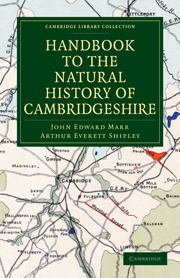Book contents
- Frontmatter
- PREFACE
- Contents
- ADDENDA AND CORRIGENDA
- PHYSIOGRAPHY
- GEOLOGY
- VERTEBRATE PALÆONTOLOGY
- ZOOLOGY
- Mammals
- Birds
- Reptiles and Amphibians
- Fishes
- Mollusca
- Insects: Introduction
- Insects: Orthoptera
- Insects: Neuroptera
- Insects: Hemiptera
- Insects: Coleoptera
- Insects: Lepidoptera
- Insects: Diptera
- Insects: Hymenoptera
- Myriapoda
- Arachnida
- Crustacea
- FLORA
- PREHISTORIC ARCHÆOLOGY
- Appendix to the Article on the Mollusca
- INDEX
- Plate section
Mammals
Published online by Cambridge University Press: 10 November 2010
- Frontmatter
- PREFACE
- Contents
- ADDENDA AND CORRIGENDA
- PHYSIOGRAPHY
- GEOLOGY
- VERTEBRATE PALÆONTOLOGY
- ZOOLOGY
- Mammals
- Birds
- Reptiles and Amphibians
- Fishes
- Mollusca
- Insects: Introduction
- Insects: Orthoptera
- Insects: Neuroptera
- Insects: Hemiptera
- Insects: Coleoptera
- Insects: Lepidoptera
- Insects: Diptera
- Insects: Hymenoptera
- Myriapoda
- Arachnida
- Crustacea
- FLORA
- PREHISTORIC ARCHÆOLOGY
- Appendix to the Article on the Mollusca
- INDEX
- Plate section
Summary
The county of Cambridgeshire cannot be said to have a rich fauna so far as the Mammalia are concerned, and although the number of species actually recorded might compare favourably with those in other counties, yet the number of those species which may be said to be truly indigenous is comparatively small.
The absence of large tracts of wood is probably no small factor in this scarcity; most of the larger animals, such as the Badger, the Marten and the Fox–as well as many species of bats and smaller rodents–being only able to maintain their existence by the shelter and food afforded them in a woodland county.
Roughly speaking, the northern half of Cambridgeshire is flat and woodless, with a few elevations, such as the Isle of Ely, standing up from the surrounding level of the reclaimed Fenland; towards the south and west the county becomes more undulating and wooded, but the district is too small for many rarities to have been found or recorded from it.
The scarcest mammal to which we can lay claim is a bat (Myotis myotis), a specimen of which was captured alive about fifteen years ago at Girton. This species, abundant on the Continent, is only known in England, to which it must be considered an extremely scarce straggler, from this and one previous example taken in the British Museum grounds at Bloomsbury.
- Type
- Chapter
- Information
- Handbook to the Natural History of Cambridgeshire , pp. 71 - 74Publisher: Cambridge University PressPrint publication year: 2010First published in: 1904

